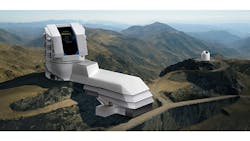Energy Dept. and NSF Plan Powerful Telescope and Camera for South America
The U.S. Energy Dept. and National Science Foundation (NSF) have finalized designs for the world’s largest digital camera. It will weigh 6,160 lb, be roughly the size of a small car (5.3 10 ft), and will take flat images that measure 25-in. in diameter and contain 3.2 gigapixels. The camera is planned as part of the large synoptic survey telescope (LSST) that the two organizations will construct 1.7 miles above sea level on Cerro Pachón, a mountain in Chile.
The camera will use a large-aperture, wide-field optical (0.3 to 1 µm) imager with a 3.5 field of view. Images will comprise almost 10 square degrees. (For comparison, the sun and moon are just 0.5 and 0.2 square degrees, respectively.) There are also six filters, each about 30-in. in diameter. Five of the filters, the ones of the g, r, i, z, and y bands, are housed in a carousel tray and can be changed in two minutes. The sixth, the u filter, must be loaded by technicians.
When the LSS goes operational in 2020, it will use the 8.3-meter telescope to take 15 second exposures every 20 seconds, generating 10 to 20 Tbytes of data each night. Over the telescope/camera’s first week, it will survey the entire visible sky. It’s predicted that in its first month, the LSST will see more of the universe than all previous telescopes combined. And over the course of its 10-year life, it will image every part of the sky over 1,000 times.
All this information presents a challenge to the LSST team. But they have developed software that can scan images from consecutive nights and highlight objects of interest based on their changes in position and brightness. Eventually, the team believes it will generate a 30 Pbyte database of over 20 billion objects.


